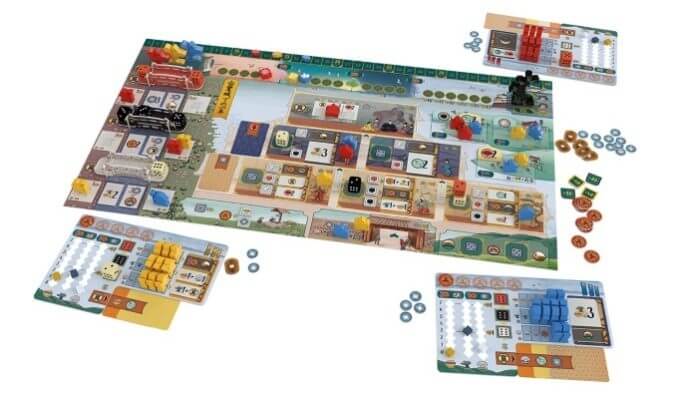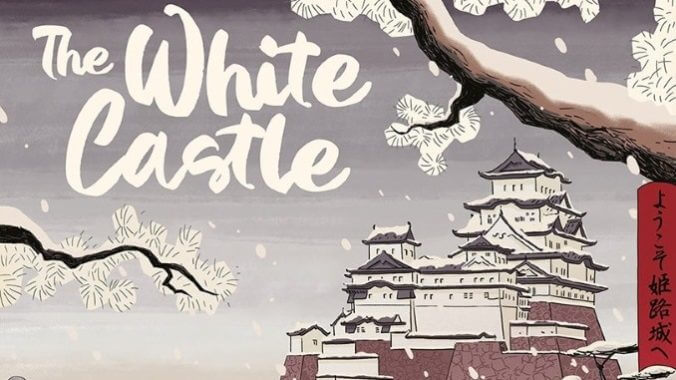The Red Cathedral came out in 2020 and was a little overlooked at the time due to the pandemic, but it’s a top 25 all-time game for me, a heavier game in a medium-sized box that plays in its promised 80 minutes and satisfies a whole bunch of things I want in a game. There’s dice-drafting, tableau-building, objective cards, and, more than anything else, it’s really fun. It’s a game that makes me think without going so far as to feel like work, and its theme, with players competing to build the Moscow cathedral of the title, integrates well with the mechanics.
The designers, who go by Isra C. and Sheid S., slid on to game shelves this past autumn with The White Castle, another 80-minute, medium-box game that punches above its class. It’s also a thinker, as each player will get exactly nine turns before the game ends, and there are several new twists in the rules that make it unique. In the final reckoning, though, I think it’s a little behind The Red Cathedral for me. Still, it topped my list of the best board games of 2023, just barely edging out Votes for Women.
In The White Castle, players do not, in fact, compete to make cheeseburgers, but to curry favor with the daimyo of the Sakai clan at Himeji Castle, which today is a UNESCO heritage site and the most-visited castle in Japan. Players will draft dice from the board, using each to take an action that will allow them to do some combination of gaining resources, placing meeples on the board, moving courtier meeples up the castle, or increasing influence. There are three rounds, and each player will select three dice per round, after which the game ends, so you have to plan wisely from the start.
The dice come in three colors and are rolled at the start of each round, after which they’re placed on the three matching bridges on the board. A player may only choose the highest-valued die or the lowest-valued one on their turn. All locations for die placement show some number of pips from 1 to 6; if you place a die with a higher value, you get the difference in coins, but if you place a die with a lower value, you must pay that difference. However, taking the lowest die from a bridge allows you to collect income, which you can increase as the game goes on in a bit of engine-building that becomes very rewarding (literally and figuratively) if you do it right.

Each player begins the game with 15 meeples, five each of gardeners, warriors, and courtiers. Warriors give you some modest immediate benefit but score points based on how many courtiers you’ve placed on the board. Gardeners also give you an immediate bonus, and they can be worth 1 to 7 points at game-end; they may also repeat their bonus at the end of the first and/or second rounds if there are still dice on the nearest bridge. Courtiers are where it’s at, though—you will start them outside the castle gates and pay to move them up through the castle’s three levels. When you move one into the first or second level, you claim the card in that room, placing it on your board over the card you already had there (you start the game with a basic one) and moving the old card into your income row, which is how you build that engine. You get 3, 6, or 10 points for each courtier in the first, second, or top levels of the castle, and getting to the top level also gives you a solid one-time bonus AND lets you take income. I think it’s the most powerful action in the game, but it’s hard to accomplish more than once.
There are five resources in the game, including money and daimyo tokens, which can be scarce depending on the cards available in any particular play. The daimyo tokens are necessary to move up the influence track, which gains you points and determines turn order for the second and third rounds. The three basic resources—food, iron, and mother of pearl—are marked on tracks on your board, which I appreciate given how many pieces this game already has.
I’m a big fan of games with engine-building (Wingspan, Gizmos, Everdell), and I’d say I’m a reasonably big fan of dice-drafting games as well (Sagrada, Dice Miner, Grand Austria Hotel, the Clever! games), so The White Castle is very much to my tastes. I love the way you build up your income, and the way the income function gives you an incentive to take the lowest die. There’s a clear sense that you’re building something, or really several things, as The White Castle progresses, but there’s also a looming time limit of the nine turns—you will not achieve all the things you want to achieve. It’s just not possible, and that adds to the excitement of playing The White Castle. You’re competing with the other players, but you’re competing even more with the clock.
It’s too easy to compare this to The Red Cathedral—they’re both from the same designers, both published by Devir, both in similar-sized boxes with the same promised playing time. I still favor The Red Cathedral for a few small reasons. One is that The Red Cathedral’s theme is more connected to the actual game play. Another is that The Red Cathedral’s solo mode is easier to play than The White Castle’s. I also get a little queasy with all of the board games designed by non-Asians that are set in Asia; BoardGameGeek lists over 800 games set in Japan, and some of the best of them, including Tokaido, Takenoko, Samurai, and Yamatai were designed by white men from France and Germany. The White Castle isn’t problematic in any way, but I also don’t think these mechanics had to be set at Himeji Castle to work.
If you haven’t played either of these games, I’d recommend starting with The Red Cathedral, because it’s a slightly better game and it will feel a little less punitive because your number of turns isn’t capped. That said, The White Castle might be easier to learn out of the box, and it’s 98% of the game that The Red Cathedral is. It’s hard to follow up a massive success, and The White Castle is a worthy successor, one that’s probably a top 50 all-time game for me as well.
Keith Law is the author of The Inside Game and Smart Baseball and a senior baseball writer for The Athletic. You can find his personal blog the dish, covering games, literature, and more, at meadowparty.com/blog.

